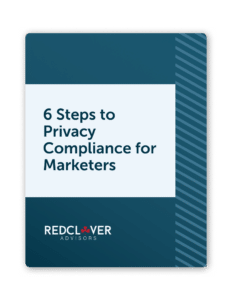Every decade comes with its own weird trends. No matter how “in” something seemed twenty years ago, you inevitably cringe when you see photos from the early 2000s and exclaim, “How did I think that was a good idea?!”
The good news is that it’s not just you. Trends aren’t just limited to fashion, and they’re influenced by factors ranging from global regulations to local consumer sentiment.
Advertisers who have to operate within the realm of data privacy compliance know this all too well.
Remember when pop-up ads were considered innovative? When collecting as much information as possible without a clear plan was a best practice? When “spray and pray” mass targeting was the height of sophistication? They’re not just outdated—they’re risky.
Advertisers today face a landscape that’s forcing them to be more thoughtful about how they do it. The agencies that figure out how to excel within the new world order? They’ll be set up for long-term, profitable success.
Advertising and privacy through the ages
The Mad Men era: when advertising operated without rules
Let’s be honest about where we came from. The golden age of advertising was built on mass media—television, radio, print, and billboards. Don Draper’s world was about crafting messages that reached millions of people at once, but without collecting individual data about any of them.
Sure, there were advertising regulations—the FTC has been cracking down on false claims since 1914.
But there were no data privacy laws because there was significantly less personal data to protect. Advertisers knew demographics and market research, but they couldn’t track individual consumers across touchpoints or build behavioral profiles.
It may be considered the golden age, but beyond the issue of rose-colored glasses, this approach only worked because advertising was one-way mass communication. You couldn’t personalize, you couldn’t retarget, and you definitely couldn’t follow someone from a TV ad to a website to an email to a purchase.
(Ironically, this model was inherently privacy-compliant because it was anonymous mass communication.)
The digital revolution allowed for unprecedented power and minimal responsibility
Early internet advertising unleashed capabilities that would have seemed like science fiction to Don Draper, but they emerged gradually over two decades.
It started simply enough. The first banner ad in 1994 was essentially a digital billboard, with no tracking or personalization. Cookies, introduced in 1994 for shopping carts, soon enabled tracking of the sites people visited.
But the main shift came in the mid-2000s with behavioral targeting. Instead of buying “women 25–34,” advertisers could target “people who visited wedding dress sites last week.” Google AdWords (2000) and Facebook ads (2007) made this accessible to any business.
By 2010, programmatic advertising enabled real-time auctions for individual ad impressions based on personal data. The business model had flipped from anonymous mass reach to personalized individual targeting.
Existing advertising regulations—designed for TV and print—didn’t address data collection, behavioral profiling, or cross-site tracking. It wasn’t that digital advertising was unregulated; these capabilities were so new that privacy laws didn’t exist to govern them yet.
The wake-up call: when consumer trust collapsed
By the mid-2010s, it was clear that the rules of digital engagement hadn’t kept up with the pace of technological change.
The European Union adopted the General Data Protection Regulation (GDPR) in 2016 as a direct response to the growing number of data breaches, outdated laws, and increasing demand for consumer control over their personal information.
So the world was already changing course when the Cambridge Analytica scandal in 2018 kicked the U.S. into high gear.
(Need a one-sentence refresh? Personal data from 87 million Facebook users was harvested without their consent for political targeting, dating back to 2010.)
It was a volcanic eruption in the world of data collection and targeted advertising.
Not-so-coincidentally, the California Consumer Privacy Act (CCPA) passed later that year. A deluge of state laws and international data privacy frameworks followed in its footsteps.
Now, it’s a whole new world out there.
The compliance reality: how new laws reshaped (and continue to reshape) the industry
To date, 19 states have officially enacted comprehensive consumer privacy laws—with more on the way, as well as a slew of laws that protect minors’ information and healthcare data. This landscape means creating compliance matrices can be tricky for even the experts.
Moreover, in the past few years alone, we’ve seen a substantial shift in the regulations associated with:
- The use of AI, especially for “high-risk” operations like biometric data collection
- Health data not covered by HIPAA, especially in Washington state
- Dark patterns that attempt to influence consumer cookie consent
- The increasing requirements to use Privacy Impact Assessments to protect consumers
CCPA fines also got a little pricier in 2025. While the individual penalty increases might seem modest—fines went from $2,500 to $2,663 per violation, there’s no ceiling on fines. That means a widespread compliance failure could easily snowball into millions in penalties. e-to-have. It’s become a business necessity, and the companies that take a proactive stance stand to save themselves a lot of headaches (and money) down the road.
How advertising agencies can use compliance as a creative catalyst
Here’s the thing: If a company claims that data privacy laws are stifling creativity, they may not be that creative. Especially when companies like Apple, LEGO, and Starbucks created major competitive advantages through customer preference centers and loyalty programs that incentivize consumer consent.
Instead of relying on third-party data brokers, agencies can help their clients establish positive relationships with consumers based on trust through preference centers, loyalty programs, and transparent marketing practices.
We know that when consumers understand what data is being collected and how it benefits them, they’re often willing to share more information with companies they trust.
And today? Consumer trust is the largest currency.
Building a trust- and compliance-first advertising framework
Here’s how advertising agencies can build compliance into their DNA.
Start with a comprehensive data inventory
You can’t protect data you don’t understand. Conduct thorough audits of all data collection points, from website analytics to email marketing platforms. Map data flows from collection through processing, storage, and deletion.
This will provide a bird’s-eye view of your data, including potential risks and vulnerabilities.
Implement consent mechanisms across all channels
Consent management platforms like OneTrust, Ketch, and Osano can help manage consent across multiple touchpoints, but implementation requires careful attention to user experience.
Consent requests should be clear, specific, and easy to understand. No dark patterns, deceptive language, or confusing privacy notices you need a law degree to understand.
Establish clear processes for privacy rights requests
Most privacy laws require companies to have clear, easy-to-navigate processes for consumers who wish to exercise their privacy rights, including access, correction, and deletion requests.
Set up dedicated workflows to handle these requests within the required timelines (generally 30 to 45 days, depending on the jurisdiction).
Manage vendor relationships proactively
Most advertising campaigns involve third-party vendors, such as email platforms, analytics tools, or ad networks.
Take some time to review your vendor agreements regularly to:
- Establish clear data processing agreements on how personal data can be handled
- Ensure vendors can support your compliance obligations, and
- Regularly audit vendor practices
Conduct regular privacy impact assessments
Privacy impact assessments are often required for high-risk data processing activities, including most targeted advertising campaigns.
And yes, these assessments should evaluate privacy risks, identify mitigation measures, and document compliance decisions, but they’re not just a checklist requirement.
With best practice implementation, PIAs can streamline operations, improve product design, and be an essential component of privacy by design implementation.
The competitive advantage of privacy leadership
The agencies that will thrive in the coming years aren’t relying on trends of the past. They’re using privacy compliance as a differentiator.
That means they’re transparent about their data practices, proactive in addressing consumer concerns, and innovative in developing privacy-friendly advertising approaches.
Ready to get started? Download our 6 Steps to Privacy Compliance for Marketing Professionals guide to learn how privacy can become your competitive advantage, then contact us to schedule a free consultation to take your business to the next level.
6 Steps to Privacy Compliance for Marketers
Our 6 Steps to Privacy Compliance for Marketers Guide breaks down everything you need to know into actionable steps you can take today.



